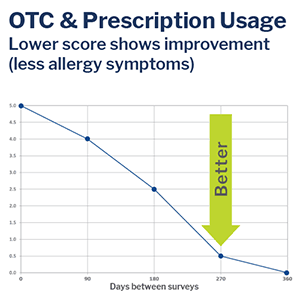How the Allergy Control Program Works
Using our turnkey Allergy Control Program, we empower employers to reduce spend and deliver patient success through onsite, near-site, DPC, and provider networks.
 1. IDENTIFY the right employees & dependents
1. IDENTIFY the right employees & dependents
- Our scored screener and your clinical spend data help you identify those who will benefit most
- We help you identify and implement streamlined diagnostic and testing tools
 2. TREAT the cause safely with allergy drops
2. TREAT the cause safely with allergy drops
- Clinically-proven tools help providers translate test results into personalized immunotherapy that patients take at home
- Therapy retrains the immune system, typically over 3-5 years
- Our licensed pharmacy handles compounding, counseling, shipping to patients, and billing based on your specific plan needs
 3. TRACK patient success throughout therapy
3. TRACK patient success throughout therapy
- Secure patient registry documents treatment success for patients, providers, and employers
- Dashboards motivate patients, guide providers, and measure progress along the way
Time for a better, proven option that fits any care delivery model!
 Focus your healthcare spend on treating the cause of allergy with a safe, proven, affordable, and flexible program to fit your current onsite, near-site, or DPC network.
Focus your healthcare spend on treating the cause of allergy with a safe, proven, affordable, and flexible program to fit your current onsite, near-site, or DPC network.
Allergychoices’ Allergy Control Program pairs the La Crosse Method™ Protocol and workflow with targeted diagnostics and personalized sublingual (under-the-tongue) immunotherapy.
- Re-trains immune system to stop reacting to allergens through at-home treatment
- Excellent safety — 275,000+ U.S. patients treated
- Protocol backed by 50+ years of clinical experience and research
- Thousands of providers trained coast to coast
- Validated patient outcomes & supporting research
 La Crosse Method™ Protocol outcomes have been validated through the Validation Institute, an independent team of population health scientists and bio-statisticians who provide objective review to validate performance in healthcare.
La Crosse Method™ Protocol outcomes have been validated through the Validation Institute, an independent team of population health scientists and bio-statisticians who provide objective review to validate performance in healthcare.
For more information, visit validationinstitute.com.










